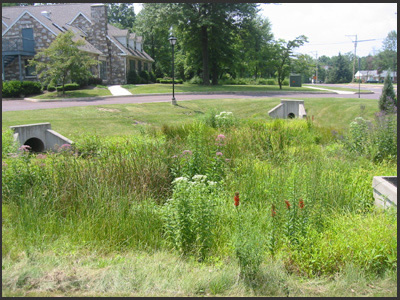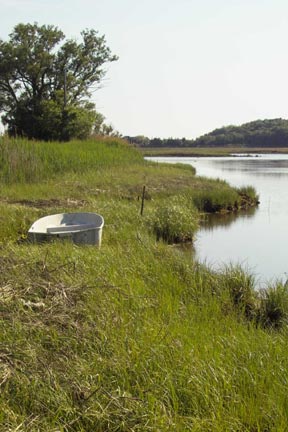What are wetlands?
Natural wetlands have been described as “earth’s kidneys", because they filter pollutants from water. Wetlands are some of the most biologically diverse and productive natural ecosystems in the world. Salt marshes, swamps, fens and bogs are all classified as wetlands. When healthy, wetlands are very productive and important habitats. They protect and improve water quality, provide fish and wildlife habitat, store floodwaters, and maintain surface water flow during dry periods.

(Image: Constructed Wetland, www.fxbrowne.com)
How does stormwater pollution affect wetlands?
Stormwater runoff naturally drains to low lying areas that include wetlands, lakes, rivers and streams. Large volumes of untreated polluted stormwater runoff from urban areas and other sources can overwhelm a wetlands natural filtration system and damage habitat. Excess sediment, pollutants, and nutrients can cause a decrease in the number of plant species present in a wetland. Sensitive plant species not able to tolerate these pollutants will be replaced by more tolerant species such as cattails and nuisance species (purple loosestrife). This change in plant species composition greatly decreases the quality of wildlife habitat. Once a wetland is degraded it can no longer provide the water quality benefits it once did.
In America, we have lost more then half of our wetlands . These wetlands have been drained and converted to farmland or filled for housing developments and industrial facilities.
In an effort to preserve and protect America's remaining wetlands, federal and state governments have enacted laws and regulations to limit development in wetlands, provided incentives for wetland restoration, and developed programs to permanently protect wetlands. In addition, reserach centers, advocacy groups, government offices, and citizen's goups have formed to conduct research, provide education, and conserve and preserve wetlands.
What you can do to protect wetlands!
Despite the efforts of governments and conservation organizations, wetland destruction and degredation continues. Many opportunities exist to protect and improve our remaining wetlands. Here are a few ways to make a difference:

- Find out where wetlands exist near your home, learn about them, and support efforts to protect and restore these wetlands.
- Encourage state and local governments to establish programs to effectively protect wetlands, especially inland wetlands, within their borders.
- Individual landowners and corporations own many of the nation's wetlands. Encourage them to protect the value and function of wetlands on their property.
- Select upland rather than wetlands sites for development projects and avoid wetland alteration or degradation during project construction.
- Maintain wetlands and adjacent buffer strips as open space.
What are constructed, or artificial, wetlands?
Constructed wetlands are treatment systems that use the natural processes involving wetland vegetation, soils, and associated microbial life to treat polluted water. Constructed wetlands are a natural way to treat stormwater and other watstewater. Constructed wetlands are often less expensive than traditional wastewater treatment systems to build and maintain. The wetland plants and associated microorganisms treat wastewater as it flows through the wetland system. As many as 5,000 constructed wetlands have been built in Europe and around 1,000 are currently in operation in the United States. Constructed wetlands differ from natural wetlands in severals ways: (1) They remain constant in size (2) They are not directly connected to groundwater (3) They accomodate greater volumes of sediment (4) They quickly develop the diversity of plants and microorganisms needed to treat wastewater.
Additional Resources
The US EPA study titled "Constructed Wetlands for Wastewater Treatment and Wildlife Habitat" presents 17 case studies of constructed wetlands. Click here for more information.
Click here to view EPA's website on constructed wetlands.
Click here to learn more about wetlands.